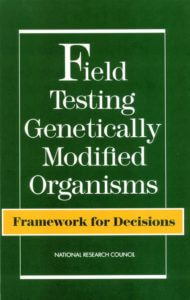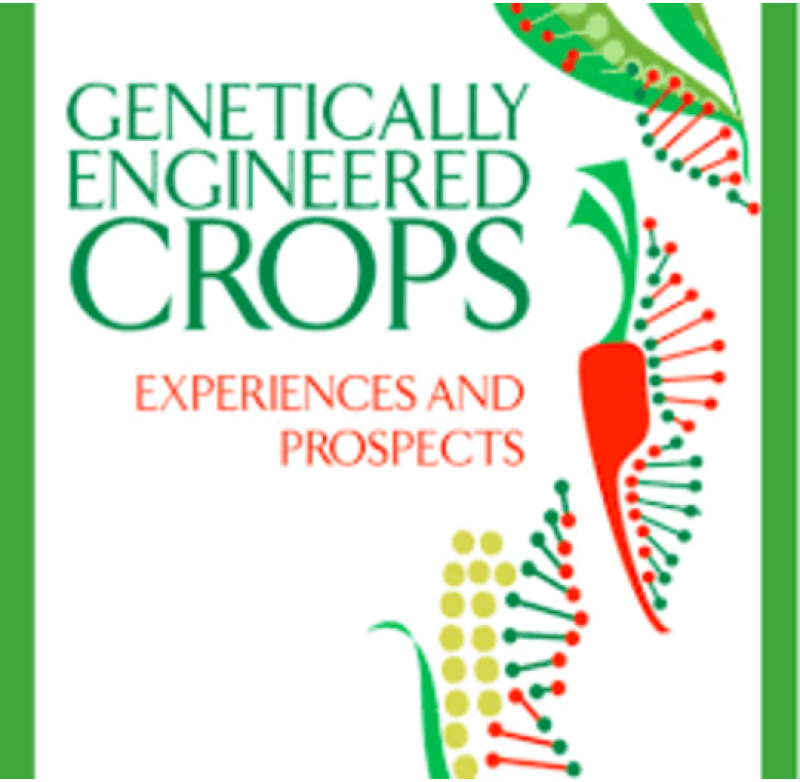Editor’s Note: This Letter to the Editor was originally published in the journal Nature Biotechnology in its December 2016 issue under the title “US National Academies report misses the mark” and is republished with permission from the authors, two prominent scientists and genetic policy experts. The authors address the National Academies of Sciences report on GMOs–“Genetically Engineered Crops: Experiences and Prospects“–released last May.
Last May, the US National Academy of Sciences (NAS) released its eleventh report since 1986 examining the safety and related policy issues of crops improved through biotechnology, commonly (if incorrectly) known as ‘GMOs’ (genetically modified organisms). This latest report, “Genetically Engineered Crops: Experiences and Prospects,” comes at a particularly important juncture, when the Obama administration has stressed the importance of biotech innovation for the United States and acknowledged the need for regulatory policy to be coordinated and update. Unfortunately, the report not only contains several important inaccuracies and omissions, but also often fails to provide background necessary to understand the complex agricultural context and environment in which genetically engineered (GE) crops are adopted. Most important, it muddies the debate about yields of GE crops compared with ‘conventionally’ bred crops, gives undue credence and prominence to views backed by paltry peer-reviewed evidence, and provides precious little direction to policymakers on how to recalibrate the regulatory framework to emphasize science-based risk assessment and reduce discrimination against GE products compared with non-GE products.
 One glaring problem of the report is its failure to acknowledge widespread yield gains in multiple countries arising from better weed control with herbicide-tolerance technology, despite many reliable reports of this in the scientific literature. The report examines yield and farm income effects in chapters 4 and 6, yet fails to refer to, or draw on, important and detailed peer-reviewed literature on the socioeconomic impacts of GE crops and many of the peer-reviewed literature cited therein. These omissions are difficult to understand, given that copies of some of these papers were sent to the NAS committee at an early stage of its review (G. Brookes and P. Barfoot, personal communication).
One glaring problem of the report is its failure to acknowledge widespread yield gains in multiple countries arising from better weed control with herbicide-tolerance technology, despite many reliable reports of this in the scientific literature. The report examines yield and farm income effects in chapters 4 and 6, yet fails to refer to, or draw on, important and detailed peer-reviewed literature on the socioeconomic impacts of GE crops and many of the peer-reviewed literature cited therein. These omissions are difficult to understand, given that copies of some of these papers were sent to the NAS committee at an early stage of its review (G. Brookes and P. Barfoot, personal communication).
In its discussion of yield gains associated with the use of GE technology, chapter 4 is particularly misleading. It cites several publications, including meta-analyses published in reputable, peer-reviewed journals, that draw on consistent findings from several studies and yet still finds a way to equivocate about these findings. The report presents unpersuasive alternative views and other possible reasons for yield differences based on a much more limited body of literature—literature that is often derived from research that is not reasonably representative of commercial farming practices.
Some of these alternative explanations highlight valid examples where no or limited yield gains from using GE technology may be found, for example, in pest-resistant varieties in years where pest pressure is low. However, these situations do not reasonably represent what most farmers using GE crops have experienced over 20 years of use (otherwise, one would not expect the observed adoption rates and high repeat index).
The issue of yield increases is complicated. There are myriad compounding variables, and it is  difficult to sort and assign the proportion of observed yield increases that derive from genetic improvements (whether from conventional breeding or traits introduced with molecular genetic engineering techniques) versus, for example, improved agronomic practices and better equipment. Some researchers have claimed an attenuation of yield increases in some crops before the advent of GE seeds, whereas others do not report such observations. But rather than grapple with this complexity, the NAS report obfuscates the issue in an odd way by focusing instead on the rate of change in the rate of yield increases with GE crops.
difficult to sort and assign the proportion of observed yield increases that derive from genetic improvements (whether from conventional breeding or traits introduced with molecular genetic engineering techniques) versus, for example, improved agronomic practices and better equipment. Some researchers have claimed an attenuation of yield increases in some crops before the advent of GE seeds, whereas others do not report such observations. But rather than grapple with this complexity, the NAS report obfuscates the issue in an odd way by focusing instead on the rate of change in the rate of yield increases with GE crops.
The report seems to suggest that since genetic engineering has apparently not increased the rate of yield increases more rapidly than classic plant breeding, the actual demonstrable increases in yields delivered to farmers by GE seeds are inconsequential and can be ignored. Farmers disagree, of course, and have cast their economic ballots for GE seeds at rates not seen with any other major innovation in the history of agriculture. (Moreover, we would note that as they began to plant GE crops, many, perhaps most, farmers did not shift completely all at once, but compared conventional and GE side by side. In view of that, the high repeat index and farmers’ collective decision to expand their cultivation of GE crops is telling.)
This unwillingness to overtly back GE crops, and the report’s efforts to give credence to alternative viewpoints—rather like the media’s obsession with giving two sides of an argument equal play, irrespective of which view is supported by the evidence—is puzzling. And it is also damaging for the following reasons.
The politically correct insistence that “every opinion” counts extends to a recommendation that “governance authorities should actively seek public input on decisions, including decisions on how to approach emerging genetic-engineering technologies…and their regulation.” Although public dialog and engagement are among the many important facets for deciding which products are developed, it is less useful for the formulation of regulatory policy, particularly when complex issues of science and technology are involved. Indeed, experience has shown that public input on arcane scientific issues is not likely to be helpful. When the US National Science Foundation funded a “National Citizens Technology Forum” in 2008, which brought average, previously uninformed Americans together to deliberate about regulatory policy toward agricultural biotech, the result was a miserable failure. Even after being ‘educated’, the group made recommendations that were unwarranted and contrary to the judgments of government and non-government scientific experts with decades of experience.
Science is not democratic. The citizenry do not get to vote on whether a whale is a mammal or a fish, the temperature at which water boils, or whether the number “pi” should be rounded off. There is no such public consultation with respect to the introduction of a new kind of flu vaccine or of new techniques of cardiovascular surgery. How does it make more sense to impose such preconditions on the introduction or regulation of new plant breeding technologies?
Another reason why the NAS report’s equivocation on the benefits of GE crops is important is the larger debate about GE technology. It is likely to confuse (perhaps even mystify) non-expert readers about the reasons for the unprecedentedly rapid adoption rates by farmers of GE seeds, and also to cause them to question whether, in fact, GE technology introduces new traits reliably and delivers yield gains for farmers. This is particularly unfortunate, given the continuing circulation of anti-genetic-engineering tropes in the general media.
 One need only look at last month’s publication in The New York Times of a highly misleading and inaccurate front-page story entitled “Doubts about the promised bounty of genetically modified crops.” The article’s premise is that commercialized GE crops in the United States have failed both to increase crop yields and to bring about an overall reduction in the use of pesticides. Although the reporting is clearly biased and based on spurious comparisons of yield data from one European country (France), the lack of clarity on yield data in the NAS report creates exactly the type of vacuum in which such inaccurate and flawed reporting and the mendacious claims of activists continue to flourish.
One need only look at last month’s publication in The New York Times of a highly misleading and inaccurate front-page story entitled “Doubts about the promised bounty of genetically modified crops.” The article’s premise is that commercialized GE crops in the United States have failed both to increase crop yields and to bring about an overall reduction in the use of pesticides. Although the reporting is clearly biased and based on spurious comparisons of yield data from one European country (France), the lack of clarity on yield data in the NAS report creates exactly the type of vacuum in which such inaccurate and flawed reporting and the mendacious claims of activists continue to flourish.
A final disappointment arising from the latest NAS report is its singular failure to provide direction to policymakers on how to build on the 25 years of evidence that has put to rest many of the initial hypothetical concerns focused on transgenic technology.

In 1989, the seminal US National Research Council (NRC) report, Field Testing Genetically Modified Organisms: Framework for Decisions, concluded that for GE plants, “the same physical and biological laws govern the response of organisms modified by modern molecular and cellular methods and those produced by classical methods.” Indeed, the NRC analysis went much further, emphasizing that modern molecular techniques “are more precise, circumscribed, and predictable than other methods. They make it possible to introduce pieces of DNA, consisting of either single or multiple genes that can be defined in function and even in nucleotide sequence. With classic techniques of gene transfer, a variable number of genes can be transferred… and we cannot always predict the phenotypic expression that will result. With organisms modified by molecular methods, we are in a better, if not perfect, position to predict the phenotypic expression.”
That says it all—plants modified with molecular techniques are an improvement over those that came before and do not warrant the current regime of discriminatory, onerous regulation. And yet the NAS 2016 report1 fails to acknowledge any of that or to build upon it using the voluminous evidence that has accumulated in the past 25 years.
Not only does the NAS committee fail to clarify that there was broad consensus in the scientific community more than a quarter- century ago, but also it provides no recognition that all experience since then has continued to reaffirm those conclusions. So why not follow the accumulated data to their obvious conclusion—that the disconnect between the risks presented by these innovations and the regulatory scrutiny to which they are currently subjected has grown from a gap into a chasm? The truth is that the current US regulatory system subjects products (improved seeds or livestock) developed with the highest levels of precision and predictability to the highest levels of regulatory scrutiny, irrespective of risk. Is that not worthy of comment and criticism by the NAS committee?
Apparently not. Instead of arguing logically that irrational, unscientific impediments to innovation need to be addressed, the latest study continues to vacillate between “recognizing the inherent difficulty of detecting subtle or long-term effects on health or the environment” (which is true for any product) and the fact that “no substantiated evidence of a difference in risks to human health between current commercially available genetically engineered (GE) crops and conventionally bred crops” has been found, and that there is no “conclusive cause-and- effect evidence of environmental problems from the GE crops.”
What’s more, in those rare cases where the NAS report does address flaws in current regulation, its proposed remedies are impractical or even counterproductive. For example, the report proposes using omics techniques that can analyze intracellular patterns of, for example, DNA (genomics), proteins (proteomics) and metabolites (metabolomics). According to this scheme, patterns in a new GE variety would be compared with a ‘comparator’, usually the parent of the new plant. The problem with this is that it is completely unclear what such comparisons would mean; we don’t know enough to correlate omics patterns to traits, let alone to hazard or risk. Although this approach may hold promise in the future, before it can be reduced to practice, enormous volumes of data will have to be developed and experience accumulated. This will take years, if not decades.
At the present stage of technology development, it is therefore unfeasible to incorporate omics-based risk assessment into US regulatory oversight. Adding this new level of complexity to an already over-stringent regulatory framework would likely bring most advanced R&D on new crop varieties to a halt. At this point in time, there is no meaningful distinction between conventional and molecular breeding—except, perhaps for the greater precision and predictability of the latter—and no basis for associating any omics patterns with hazard or risk parameters. But by putting this forward in its report, NAS is sending a clear message to regulators that such data should be required for all new varieties, regardless of the characteristics of the plant or the altered traits or the presumptive risk, although we have long known that such a wide and dense regulatory net is not necessary. The California farmer who created the first ‘pluot’ (a plum-apricot hybrid) or a high school student who irradiates corn seeds to create mutants for a science project has not caused safety problems; why should they have to perform onerous omics-based analyses before approval by regulatory authorities? The NAS’s omics proposal is, in effect, a baroque hypothetical future solution to a non-existent problem.
The 2016 NAS study is thus a missed opportunity. On issues involving the interface of science and government policy, the NAS has a bully pulpit. For the present report, the Committee pulled together a formidable body of data and experience, but in an apparent effort to be inclusive and to air all points of view, they have created an unwarranted and misleading moral equivalence, as if they were reluctant to follow the data where they lead.
In our opinion, the studies and experience cited by the NAS could not be clearer: Crops and foods improved through biotech have delivered prodigious benefits to farmers, consumers, and the environment. They have not solved all farmers’ problems perfectly and without complications, to be sure, but no issues or problems that have emerged over the past three decades are unique to, or depend on, the use of molecular techniques, and no unique hazards or risks have been identified. In view of these evidence-based findings, it is not possible to justify risk assessments and regulatory regimes that single out these products for special review, much less a higher degree of scrutiny than the products of other forms of plant or animal breeding and improvement. There are simply no data, and there is no experience that supports such an approach. Regulatory regimes that take such a prejudicial, asymmetrical approach to the products of precision agriculture are therefore intrinsically suspect and, we would argue, should be vigorously condemned as anti- science, anti-innovation, and anti-social.
 The latest announcement from the US Office of Science and Technology Policy suggests that the US Coordinated Framework for the Regulation of Biotechnology, promulgated in 1986, is unlikely to be undergoing major revisions—although there are plans for new guidances and user- friendly resources to help small companies and academic institutions navigate the current system. But drastic changes are needed because the average cost of regulatory authorization of a new trait introduced between 2008 and 2012 was at least $45 million. Only the world’s largest seed and agrochemical companies can afford to innovate under such a regulatory regime, and for the most part even their development programs have been limited to vast-scale commodity crops.
The latest announcement from the US Office of Science and Technology Policy suggests that the US Coordinated Framework for the Regulation of Biotechnology, promulgated in 1986, is unlikely to be undergoing major revisions—although there are plans for new guidances and user- friendly resources to help small companies and academic institutions navigate the current system. But drastic changes are needed because the average cost of regulatory authorization of a new trait introduced between 2008 and 2012 was at least $45 million. Only the world’s largest seed and agrochemical companies can afford to innovate under such a regulatory regime, and for the most part even their development programs have been limited to vast-scale commodity crops.
The NAS report was an opportunity to remind policymakers (and other readers) of the fundamental risk-based principles that were among the original tenets of the US Coordinated Framework. In recent years, implementation of regulations for GE products has departed so far from that foundational guidance that it bears little relationship to actual risk. As a result, regulatory requirements impose egregiously disproportionate constraints on GE products with lower hazards and risk potential than those crafted with conventional genetic modification techniques. In other words, federal agencies have created regulatory regimes in which risk is inversely related to the degree of regulatory scrutiny.
Such unscientific, unnecessarily expansive regulatory regimes create massive disincentives to research, development, and innovation while delivering no benefits whatsoever in terms of safety or improved sustainability. And yet, although it was an essential facet—perhaps the most essential facet—of the NAS committee’s mandate, a discussion of the burden of unscientific, process-based regulation, and the need for regulatory reform to relieve that burden, were inconceivably absent from its report.
In conclusion, the 2016 NAS report contains far more equivocation than the data justify. Despite abundant, unambiguous lessons from experience, it fails to offer US policymakers clear, concise conclusions and recommendations on the single most salient and critical policy issue—the need for regulatory rationalization to make government oversight of new plant varieties scientifically defensible and risk-based.
Val Giddings is Senior Fellow at the Information Technology & Innovation Foundation. He previously served as vice president for Food & Agriculture of the Biotechnology Industry Organization (BIO) and at the Congressional Office of Technology Assessment and as an expert consultant to the United Nations Environment Programme, the World Bank, USDA, USAID, and companies, organizations and governments around the world. Follow him on twitter @prometheusgreen.
Henry Miller is a Robert Wesson Fellow at the Hoover Institution. He previously served for fifteen years that US Food and Drug Administration in a number of positions. In recent years he has written articles for a wide spectrum of scholarly journals and popular publications, and is a regular contributor to Forbes.com. Follow him on Twitter @henryimiller.































